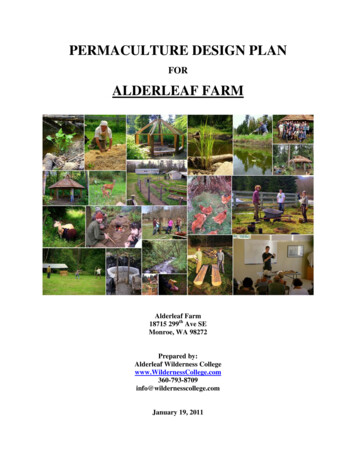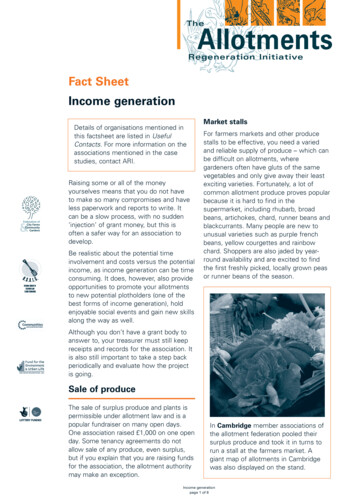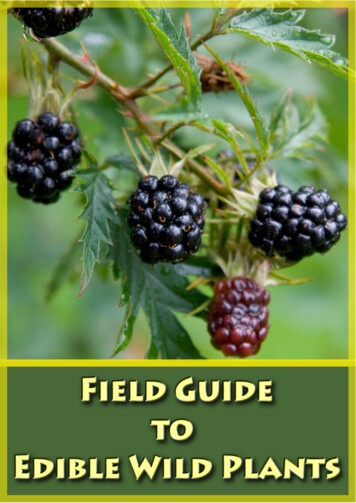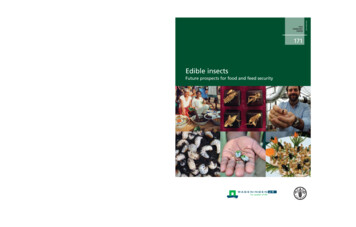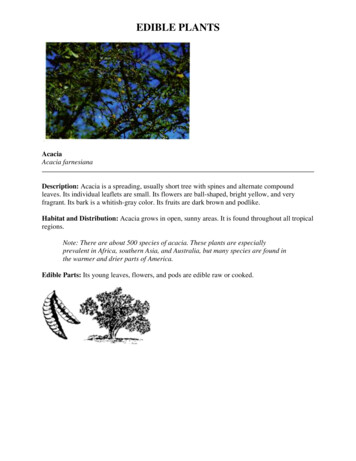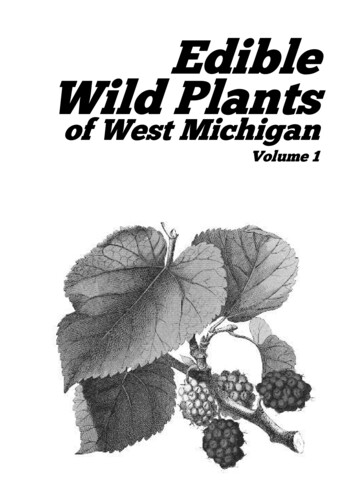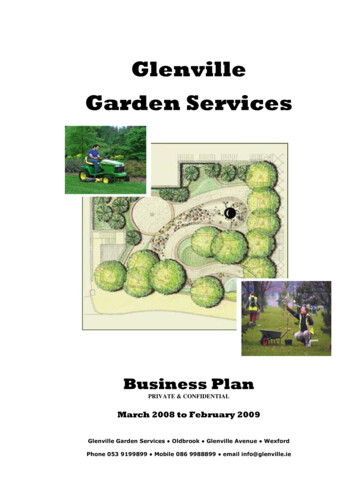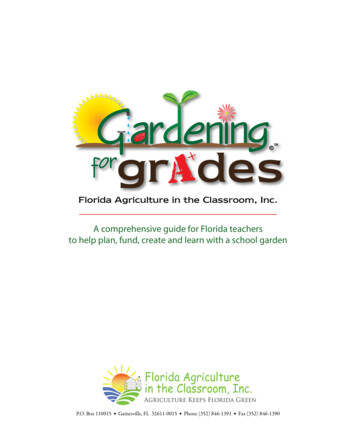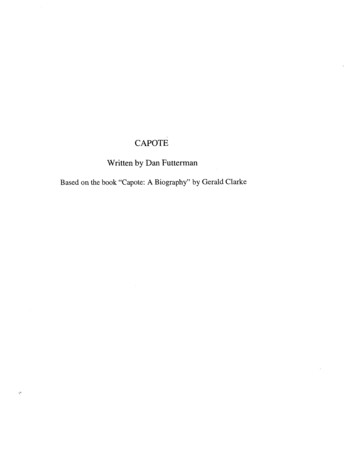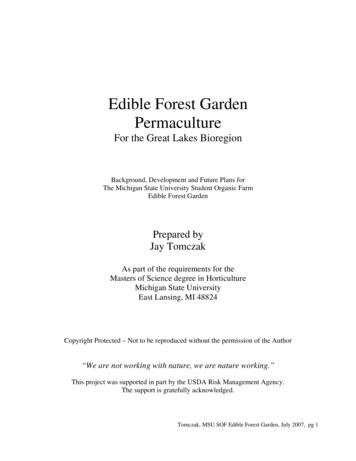
Transcription
Edible Forest GardenPermacultureFor the Great Lakes BioregionBackground, Development and Future Plans forThe Michigan State University Student Organic FarmEdible Forest GardenPrepared byJay TomczakAs part of the requirements for theMasters of Science degree in HorticultureMichigan State UniversityEast Lansing, MI 48824Copyright Protected – Not to be reproduced without the permission of the Author“We are not working with nature, we are nature working.”This project was supported in part by the USDA Risk Management Agency.The support is gratefully acknowledged.Tomczak, MSU SOF Edible Forest Garden, July 2007, pg 1
Table of ContentsTopicTitle PageTable of ContentsPrefaceIntroductionSection 1 Background Information and Literature ReviewAgroforestryPermacultureEdible Forest Gardens and Multistrata HomegardensCommon Design Principles for Temperate ClimatesEcosystem BenefitsLiterature CitedSection 2 Development of the MSU SOF Edible Forest GardenPlot DescriptionDesign ProcessImplementation and Cultural PracticesPlant Material Sources and CostsFinal Plant List and Figures for MSU SOF EFGSection 3 Management and Maintenance Plan for the MSU SOF EFGSeason PlanLong Term PlanSection 4 MSU SOF EFG Pest ManagementPrinciplesPracticesConsiderations for Some Common PestsAdditional LiteratureEFG SummaryAppendicesFrequently Asked Questions about the MSU Edible Forest GardenEFG Permaculture ResourcesExamples of PermacultureCultivar Plant List and MapSite Evaluation for the SOF by Mark ShepardSuccessional Brushland and Oak Savanna by Mark ShepardEndPage 26364695672758395Tomczak, MSU SOF Edible Forest Garden, July 2007, pg 2
PrefaceAbout the time I was working with students to develop the ideas and plans for the MSUStudent Organic Farm, I was working with an off campus faith community to build a meditation andprayer labyrinth. When walking the completed labyrinth, it was obvious that I had a hard timeslowing down – not unlike the challenge people have when it comes to slowing down for meals andto consider “where food comes from”. Somewhere during the walking and meditating, the pictureof a food labyrinth garden worked up to the surface - concentric circular paths with gardens inbetween for walkers to experience and savor the flavor.The plot that eventually became the Student Organic Farm Edible Forest Garden wascovered in straw and wood shaving bedding for sheet composting with a food labyrinth image inmind. I had watched the newly planted cherry trees that were part of the last experiment on thatplot struggle in the heavy clay subsoil. I had also watched the rapid growth of my own newlyplanted fruit trees at home in the site I had prepared with sheet composting for two years prior toplanting. The soil was fed first, and the quack grass was given the opportunity to become soilorganic matter of a different kind.The Edible Forest Garden that Jay Tomczak and helpers created on the site far exceeds anypicture I ever conjured in my head. While the planting is just over a year old, it is an incrediblecollection of plant material with an inviting and creative layout. It is indeed an inviting foodlabyrinth. Not concentric rings, but paths and pockets, spaces and guilds that will take years todevelop. It captures the imagination of most everyone that hears about it or walks through it.If you need to see your food crops in straight lines and well protected from the competitionof other plants, you probably won’t readily understand or appreciate the Edible Forest Garden.There is going to be a lot of competition, likely too much for some crops. But the garden is anexperiment.Not a traditional replicated and statistically valid experiment. It is however anexperiment that hopefully will nurture more questions than it answers. What happens when the soilis not regularly tilled? Can apples or peaches on dwarfing root stocks produce fruit in thisenvironment? Will the predators and the “pests” stay in balance? The SOF EFG is a chance to putmany different ideas together and to see what happens over time.Jay Tomczak came to the SOF as an undergraduate in Fisheries and Wildlife Managementand equally importantly as one of many students in the RISE specialization (Residential Initiativefor Study of the Environment). While knowledgeable and mostly self taught about survival skills,wild edible plants, and “peak oil” issues, Jay had not yet experienced much horticulture orpermaculture. During his time at the SOF, his highly motivated self learning style, together withmentoring from Laurie, Michelle, Emily, Jeremy and Corie, he worked to understand the StudentOrganic Farm and help manage it. He also quickly became a wealth of information aboutpermaculture and edible forest gardening. Through his effort, Mark Sheppard and David Jacke cameto the SOF and became his mentors. He is now regarded as one of the key permaculture resourcepeople in Michigan.One of the goals of the SOF is to invite people to think more about the food they eat and thefarmers who grow it. Another is to foster diversity. Jay has helped create a space that will servethose functions for many years to come. Enjoy his summary of edible forest gardening and the storyof how it happened at the MSU-SOF.John Biernbaum, Professor of Horticulture and SOF Co-Advisor July 2007Tomczak, MSU SOF Edible Forest Garden, July 2007, pg 3
IntroductionThis project began as more than just a Horticulture Masters of Science thesis project. In myearliest memories as a child I had a devoted interest in edible native plant species which wasstrongly encouraged by my parents. While many youth my age were focused on athletic pursuits, Ibegan intensively studying the indigenous skills of hunter-gatherers and dreamed of being able tocut the umbilical cord of society and live free in my native ecosystem.While studying Fisheries and Wildlife Management at Michigan State University I becameinterested in local and global community food security. I came to the realization that I was part ofan ecological community that is in danger of becoming vanquished by improper earth stewardshipand that humanity is a vital part of that community. Recognizing that with 6.6 billion people in theworld we could not all be hunter-gatherers nor would that be desirable, I began a very personalsearch for humanity's ecologically sustainable niche within the biosphere. While working with ananthropologist named Kevin Finney I learned about the polyculture practices of indigenous peoplesand felt that the answers lay somewhere within the realm of a sustainable agriculture.It was near the end of my undergraduate studies that I joined the MSU Student OrganicFarm (SOF) and instantly felt affirmation. Despite all of humanity's technological advances anddisconnect from the earth, we are still an “agrarian” society completely dependent on agriculture.While working and studying with John Biernbaum and the SOF I began graduate studies focused onpermaculture. It seemed like the perfect balance. Permaculture is based on the premise that a stable,sustainable culture cannot exist without an integrated relationship with a system of sustainableagriculture. “We are not working with nature, we are nature working.” This realization has becomea guiding force on my path. The MSU Edible Forest Garden is the culmination of my last threeyears of studies and searching.The report that follows is intended as a resource for students at the Student Organic Farm,for students at other college and university based food system projects, and for farmers and urbangardeners interested in pursuing permaculture and the edible forest garden as either a commercialproduction or personal use food production method. While the Section 1 Review of Literatureprovides the background information in agroecology and permaculture, it does not includeinformation about two key factors that provide a motivation for the edible forest garden. Over thelast three years I spent great effort learning about the issues of food security and fossil fueldepletion. Before addressing the edible forest garden, I would like to briefly address these veryimportant motivations.Food Security. For me, developing an understanding of permaculture started with attemptingto understand the state of food security and the limiting factors regulating the current food system.All species on earth require energy (e.g. solar) and resources (e.g. renewable and non-renewable) toexist and thrive and it is the supply of vital limiting resources that regulate population growth.The threat of hunger has been a persistent problem for humanity, and today with great surpluses offood being produced globally, it is the restricted access to this food that plagues many poorcommunities (Caraher et al 1998). More recently, some of the most well fed members of our societyare waking up to the vulnerabilities of their fossil fuel dependent meals and realizing that they too,may soon face the realities of a food insecure world (Genauer 2006). After the inadequacy of theindustrial food system in achieving food security amidst agricultural abundance, many communitydecision makers and informed citizens are realizing that a new holistic approach to food securitymust be implemented (Allen 1999). Giving people food does not make a food secure community.Creating appropriate social networks and empowering people economically is what makes acommunity food secure (Delind 1994, Wekerle 2004).Tomczak, MSU SOF Edible Forest Garden, July 2007, pg 4
The modern industrial food system converts cheap, abundant fossil fuel energy intoagricultural commodities (e.g. corn and soy). These commodities must then be heavily processed orconverted into animal food products and distributed throughout the global market before eventuallybeing consumed by people. This industrialized food system has traditionally focused on producingas much food as possible, as cheaply as possible (Pollen 2006). Under traditional economic doctrineit is believed that if massive amounts of cheap food are produced, hunger will disappear. Access toand consumption of this food has been dealt with as a separate issue (Allen 1999). Because thissystem inadequately provides access to nutritious food for low income communities, emergencyfood programs based on the charity model, such as food banks, soup kitchens, food stamps andWomen Infant and Children programs (WIC) have proliferated. These charitable food organizationsare essential for responding to actual short term food emergencies. This system is inadequatebecause these organizations (mainly private) are depended on to supply the long term food needs ofpeople in chronic poverty. Demand for this emergency food has continued to grow rapidly since the1980's. This rise in demand for emergency food programs is attributed to the impact of large federalcutbacks in food assistance programs and the assault on the welfare state by the Reagan and Bushadministrations (Poppendieck 1994). These programs do not adequately provide food security,because the clients have no legal, enforceable rights to the food being provided, it is heavilydependent on volunteers and donations, there is no mechanism for determining the location andavailability of such programs and the availability of quality food is very unreliable. Often, thedisproportional ability of minority groups to access food is not appropriately addressed. Theseprograms are being perpetuated due to the undermining of the welfare state (i.e. Society has becomeaccustomed to discretionary giving as an acceptable way to combat hunger) and the diverting ofenergy of food advocacy organizations away from more considerable advances in combating hungerand poverty (Poppendieck 1994).The community food security and food justice movements are developing in response to theinsensibility of perpetuating emergency food programs that are responding to a never endingemergency (Poppendieck 1994). This justice model is developing as a social movement that isrelocalizing food systems and disconnecting them from corporate control (Wekerle 2004). This isbeing done buy addressing the issues from a holistic perspective on multiple scales. Advocates arepaying greater attention to regulations and policies at the federal and state level as well as the localordinances. Food security is being re-framed as part of a democratic and just society. Grassrootsorganizations are working together with communities to reconnect them mentally, physically andpolitically with their food system and their food culture. These movements are focusing on civilsociety as a space for organizing policy and practices (Delind 1994, Wekerle 2004). Someimportant elements are programs that allow:z Low-income family's access to fresh, quality food (e.g. project fresh)z Rezoning neighborhoods for community gardens which provide space for food procurementand social networking around food culturez Facilitating the creation of new farmers marketsz Connecting communities with small farmers and CSA's (community supported agriculture)Placing food procurement and the sharing of local resources at the center of community life buildsand empowers communities. This will not replace emergency food programs, but rather allow themto be used for emergencies, not long term food procurement. This frees up the energy of many foodadvocacy organizations to work toward a more sustainable food system (Delind 1994).The principles of the permaculture philosophy can be used as a framework for developingsocial, economic and ecological sustainability in a food insecure community. From its conception,permaculture has had a strong emphasis on developing relationships between communities andTomczak, MSU SOF Edible Forest Garden, July 2007, pg 5
agriculture for the purpose of creating a stable, secure, localized food system. Permaculture systemsseek to amend the vulnerability and destructiveness of the modern industrial food system(Holmgren 2002). Permaculture food systems make efficient use of energy, labor and materialresources and maximize synergistic relationships and yield. Establishing increased food security ina community requires a holistic approach. A food system can not be sustained in isolation and needsto be integrated with a network of social, economic and environmentally sustainable practices.Fossil Fuel Dependence. Aside from issues of food access affecting low incomecommunities, some food system vulnerabilities that affect food security for global society are fossilfuel dependences. The major limiting resources regulating the current food system are nonrenewable fossil fuels which will soon become increasingly scarce and expensive. This dependenceis a threat to food security and future food supply. For most of the last 10,000 years, agriculture hashad balanced energy and nutrient cycles, which appropriated the solar energy harnessed byphotosynthesis (Chancellor and Goss 1976, Smil 1991). Taking advantage of cultural practices suchas crop rotations, green manures and draft animals allowed for humanity to live within theregenerative capacity of the biosphere (Bender 2001, Wackernagel et al 2002). The current foodsystem can be viewed as a system that converts non-renewable fossil fuel energy into food (Hellerand Keoleian 2000, Pimentel and Giampletro 1994). Currently about 10 to 15 calories of fossil fuelenergy are used to create 1 calorie of food and although it only uses about 17% of the U.S. annualenergy budget it is the single largest consumer of petroleum products when compared to any otherindustry. It requires about 1,500 liters of oil equivalents to feed each American per year(Hendrickson 1996). As long as the energy resources are cheap and abundant the inefficiencies areunimportant, however dependence on finite resources is quite a vulnerability when those resourcesbecome scarce (Gever et al 1991).The U.S. food system has had three main periods of change which have brought it to thecurrent condition of fossil fuel dependence (Gever et al 1991). The first was the expansionist periodoccurring between around 1900 and 1920. In this period, increases in food production were a factorof putting more land into production, with no real breakthroughs in technology. The second was theintensification period, also called the “green revolution” which occurred between around 1920 and1970. In this period technological advances allowed for the exploitation of cheap abundant fossilfuel energy resulting in a seven fold increase in productivity (output per worker hour). Farmmachinery, pesticides, herbicides, irrigation, new hybrid crops and synthetic fertilizers allowed forthe doubling and tripling of crop production and the corresponding growth of the human population(Gever et al 1991, Ruttan 1999). We are currently in the saturation period of agriculturecharacterized by greater amounts of energy required to produce smaller increases in crop yield (i.e.the ratio of crop output to energy input is diminishing). An ever growing amount of energy isexpended just to maintain the productivity of the current system; for example about 10% of theenergy in agriculture is used just to offset the negative effects of soil erosion and increasingamounts of pesticides must be sprayed each year as pests develop resistance to them (Gever et al1991, Pimentel and Giampletro 1994).Aside from being dependent on non-renewable resources, agriculture is also rapidlydiminishing the ability of vital “renewable” resources to regenerate (Pimentel and Giampletro 1994,Wackernagel et al 2002). Of these resources water and topsoil (humus) are most limiting. Waterscarcity associated with agriculture is typically a regional issue. In the western U.S. the ColoradoRiver has had so much water diverted from it that it no longer reaches the ocean and the greatOgallala aquifer is being overdrawn at 130 to 160% its recharge rate (Pimentel and Giampletro1994). Other problems are the vast amount of pollution associated with agricultural runoff, whichdegrade aquatic ecosystems and create dead zones in the ocean (Matthews and Hammond 1999).Tomczak, MSU SOF Edible Forest Garden, July 2007, pg 6
Approximately 90% of U.S. agricultural lands are losing topsoil above sustainable rates (1t/ha/yr)due to erosion and the application of synthetic fertilizers actively promotes soil degradation (Geveret al 1991, Pimentel and Giampletro 1994). Other considerations are the loss of biodiversity due toclearing land for large monocrops as well as agricultures contribution to global climate change byway of its CO2 and methane by products (Pirog et al 2001, Wackernagel et al 2002).The food system is currently dependent on fossil fuels for powering irrigation pumps,petroleum based pesticides and herbicides, mechanization for both crop production and foodprocessing, fertilizer production, maintenance of animal operations, crop storage and drying and forthe transportation of farm inputs and outputs. Of these fossil fuel dependences, some are moreeasily overcome than others (Ruttan 1999). It has been estimated that 95% of all food productsrequire the use of oil at some point in the production process. For example, just to farm a single cowand deliver it to market requires the equivalent of 6 barrels of oil (Lucas et al 2006). Due to theircurrent necessity, dependence on synthetic nitrogen fertilizer and the long distance transport of farminputs and outputs are two outlying limiting factors that exemplify the vulnerability of the currentfood system and therefore require further analysis (Smil 1991, Pirog et al 2001).In terms of its necessity for the existence of a large portion of the global population, themost important invention of the 20th century is the Haber-Bosch process for the synthesis ofnitrogen fertilizer. Nitrogen accounts for 80% of volume of atmospheric gas but it is in a nonreactive form that is not readily available to plants, making it the main limiting factor for globalcrop production and human growth. It is a vital component of chlorophyll, amino acids, nucleicacids, proteins and enzymes. Synthetic N is responsible for raising crop yields approximately 35 to50% over the last half century accounting for 80% of the increase in cereal crops, without whichmuch of the population would not exist (Smil 1991).For most of human existence N fixation (i.e. the splitting of N2 to form Ammonia) waslimited to bacteria (primarily Rhizobium). With the invention of the Haber-Bosch process in 1913humans began domination of the N cycle (Smil 1991). This process is extremely energy intensiverequiring the reaction of 1 mole of nitrogen gas with 3 moles of hydrogen gas under temperatures ofapproximately 400 C and pressures of approximately 200 atmospheres (Marx 1974). This accountsfor 30% of the energy expenditures in agriculture. The hydrogen gas for this process comes almostexclusively from natural gas which is considered as a feedstock and not factored in as part of theenergy expenditure (Hendrickson 1996). It is also possible to get the required hydrogen from theelectrolysis of water but this requires more energy, making it an unfavorable alternative at this time(Gilland 1983). Natural gas currently accounts for 90% of the monetary cost of N fertilizer (Wenzel2004).Other obstacles associated with N fertilizer are production capacity, transport, storage,application and N saturation. Crops only absorb about half of the nitrogen they are exposed to,much of the rest runs off the fields with water flow, saturating the environment and pollutingaquatic ecosystems (Matthews and Hammond 1999, Smil 1991). Between 1950 and 1989 fertilizeruse increased by a factor of 10 and it has since had continued growth. In developed nations much ofthat use produces animal feed which is converted into more animal product consumption. However,in lesser developed parts of the world such as Asia which currently accounts for 50% of fertilizeruse, crop yield for direct human consumption has been increased (Matthews and Hammond 1999).In many developing countries access to fertilizer and proper application are still often a limit to cropproduction (Hardy and Havelka 1975).Although synthetic nitrogen fertilizer and its dependence on natural gas is a major limitingfactor of the industrialized food system, perhaps the greatest vulnerability is the dependence on thetransportation system for farm inputs and outputs; for example fertilizer is of little value if it can notTomczak, MSU SOF Edible Forest Garden, July 2007, pg 7
be effectively delivered to where it is needed (Hardy and Havelka 1975, Heller and Keoleian 2000,Pirog et al 2001). In the U.S. long distance food transportation is often a luxury, providing us with“fresh” produce and seafood from exotic places at any time of year (Gever et al 1991). The meandistance U.S. food travels is now estimated at 1,546 miles but this distance varies greatly dependingon the food item (Pirog et al 2001). One of the primary reasons for this, is that 90% of the freshvegetables consumed in the U.S. are grown in the San Juaquin Valley, California (Heller andKeoleian 2000).Although the transport of food uses a relatively small amount of the U.S. energy budget, it isimportant to realize that it is a vulnerability for food security (i.e. many communities do not havethe infrastructure to produce even non-luxury food items). Currently 6 to 12% of the food dollar isspent to account for transportation costs, however U.S. tax dollars heavily subsidize highwaymaintenance and the oil industry so the true cost is much greater (Hendrickson 1996). Consideringthe importance of long distance transportation to our food supply, the cost of food and the securityof our food supply is very dependent on the cost and availability of oil (Gever et al 1991, Lucas etal 2006).Fossil Fuel Depletion. The fossil fuels which are most important to the food system are oiland natural gas. Both of these are finite resources and therefore began being depleted the momenthumans started using them. When graphed over time, production (synonymous with extraction) ofthese resources follows a bell shaped curve. The high quality easily produced (cheap) resource isproduced first (on the up slope), followed by a peak or plateau in production, then the progressivelyharder to extract lower quality (expensive) resource is produced on the down slope of the curve(Bently 2002, Campbell 2004, Gever et al 1991). When peak production occurs we know thatroughly half of the resource remains, however much of it will never be produced because itbecomes to energy intensive (expensive) to do so (i.e. it takes increasingly more energy to produceincreasingly less energy and when that ratio (energy profit ratio) reaches 1, it is no longer an energysource, it is an energy sink). This model for resource depletion is what is known as Hubberts peak(Gever et al 1991). The production of all conventional hydrocarbons will soon begin to decline andsupply shortages will be inevitable (Bentley 2002, Campbell 2004).Global natural gas reserves are difficult to assess relative to that of oil due to lack of reliabledata, however we do know that the majority of gas left to extract is in the middle east and Russia(Bentley 2002). Global gas reserves are also somewhat less of a viable supply than regional reservesbecause of the cost and limited capacity to transport gas by ship. To transport gas over the ocean itmust first be liquefied and shipped in tankers designed especially for this purpose, and then broughtto regasification facilities of which there is limited capacity. All of these steps lower the energyprofit ratio. All of the worlds 156 gas tankers are currently under long term contract. World shipbuilding capacity is 20 ships/year and the U.S. has ordered 18 ships for delivery by 2008 (Duffin2004).Understanding the regional gas supply is important because gas is most easily transported bypipeline. U.S. gas production peaked in 1973 and production has remained relatively constant forthe last two decades (Paris 2004). More recently new wells have been progressively smaller andnow average 56% depletion in the first year. Over the last few years drilling has increased whileproduction has declined. The demand for gas is projected to increase 50% by 2020 and the U.S.known reserves are expected to last less than 8 years (Duffin 2004). Global natural gas production isexpected to peak within the next 20 years and with a 2% decline in North American gas production,supply is expected to fall short of projected demand by around 2008 (Bentley 2002, Duffin 2004).U.S. oil production peaked in 1971, however unlike natural gas, oil is more easilytransported, which makes understanding global production important (Bentley 2002). The peak ofTomczak, MSU SOF Edible Forest Garden, July 2007, pg 8
onventional global oil production is expected to occur sometime this decade and many expertsbelieve we may have already reached a production plateau (Bentley 2002, Gever et al 1991, Pirog etal 2001). Part of how peak oil production is estimated is by knowing the peak of oil discovery, sincemore oil can not be produced than is discovered (Ivanhoe 1997).Global oil discoveries peaked back in 1962 and have declined steadily ever since (Bentley2002). We now consume approximately 5 barrels of oil for every new barrel discovered each year,using increasingly more of our reserves from past discoveries (Ivanhoe 1997). The trend that isperhaps most discouraging is the dramatic drop and progressive decline in the energy profit ratiosince the 1970's (Gever et al 1991). Demand for oil is growing at 2-3% per year, while production isdeclining at an average of 4-6% per year (Lucas et al 2006). These trends indicate that if wecontinue on our current consumption path we will soon experience fossil fuel supply shortages.It is time that we leave behind the saturation period of agriculture and develop a new moreefficient and ecologically sustainable food system. Permaculture provides a potential framework fordeveloping this food system.This publication has been organized and prepared with the intent of providing a valuableresource for the continued development and implementation of the SOF EFG as well as for futurefarmers and urban gardeners seeking to apply the concepts of temperate edible forest gardenpermaculture. There is still so much to learn, but following is a short summary of several yearseffort. Please refer to the Table of Contents for a summary of the topics and organization.I want to thank my parents and all those wonderful souls that helped guide me during thosepivotal junctions of this path.namasteJay TomczakJuly, 2007Tomczak, MSU SOF Edible Forest Garden, July 2007, pg 9
Introduction Literature CitedAllen, P. 1999. Reweaving the food security safety net: mediating entitlement and entrepreneurship.Agriculture and Human Values. 16:117-129.Bender, M. 2001. Energy in agriculture and society: insights from sunshine farm. The LandInstitute. 001/03/28/3accb0712Bentley, R.W. 2002. Global oil and gas depletion: an overview. Energy Policy. 30:189-205.Campbell, C.J. 2004. Oil and gas production profiles. Association for the Study of Peak Oil andGas. http://www.aspo-global.orgCaraher, M. et al. 1998. Access to healthy foods: part I. Barriors to accessing healthy foods:differentials by gender, social class, income and mode of transport. Health EducationJournal. 57:191-201.Chancellor, W.J. and J.R. Gross. 1976. Balancing energy and food production, 1975- 2000. Science,New Series. 192:213-218.Delind, L.B. 1994. Celebrating hunger in Michigan: a critique of an emergency food program andan alternative for the future. Agriculture and Human Values. 11:58-68.Duffin, M. 2004. The energy challenge 2004: natural gas. Energy rticle display.cfm?a id 828Genauer, E. 2006. Peak oil and community food security. Communities: J
Edible Forest Garden . Permaculture . For the Great Lakes Bioregion . Background, Development and Future Plans for . The Michigan State University Student Organic Farm . Edible Forest Garden . Prepared by . Jay Tomczak . As part of the requirements for the . Masters of Science degree in Horticulture .
